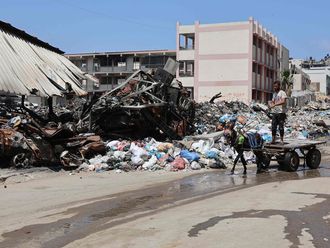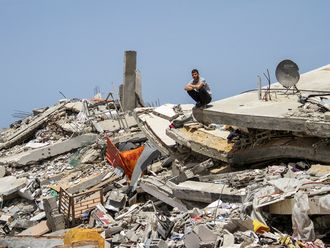Washington: US defence officials are accusing Iran of increased meddling in Syria, including efforts to bolster its flagging armed forces, who are weary after 18 months of war.
Defence Secretary Leon Panetta said Iran is building and training a militia to help President Bashar Al Assad’s regime battle the rebel fighters trying to topple him.
The Iranian efforts, said Panetta, will only add to the killing going on in the country and “bolster a regime that we think ultimately is going to come down.”
Sitting alongside Panetta at a Pentagon news conference on Tuesday, Army General Martin Dempsey, chairman of the Joint Chiefs of Staff, said the militia, which is generally made up of Syrian Shiite forces, is being used to take the pressure off the Syrian regime forces.
“Any army would be taxed with that kind of pace,” Dempsey said. “They are having resupply problems, they are having morale problems, they are having the kind of wear and tear that would come of being in a fight for as long as they have.”
Dempsey also said that it appears Syrian rebels were able to shoot down a Syrian warplane but said he has seen no indication that they are armed with heavy weapons or surface-to-air missiles, at least not yet.
He says the MiG fighter could have been shot down with small arms fire. Syria has blamed the crash on a technical malfunction, but Dempsey said the cause “didn’t appear to be mechanical.”
Dempsey and Panetta voiced concerns about Iran’s growing presence in Syria even as President Bashar Al Assad’s regime steps up its aerial attacks against the rebel forces. Fierce fighting and attacks from warplanes and helicopter gunships have pushed the opposition forces back on key fronts, such as Aleppo.
And the fighting — including alleged massacres by the regime — has led to the deaths of more than 20,000, according to activists.
Asked about military options for intervention in Syria, Dempsey said the US has been in discussions with Jordan and Turkey about the possible need for a safe zone because the two countries neighbouring Syria are seeing an influx of refugees fleeing the fighting.
“And with a safe haven would probably come some form of no-fly zone, but we’re not planning anything unilaterally,” Dempsey said.
Panetta repeated assertions he made during an Associated Press interview on Monday, saying that right now, creating a no-fly zone in the region “is not a front-burner issue” for the US. Instead, he said, the US is focusing on providing humanitarian and nonlethal assistance and on ensuring the chemical and biological weapons in Syria are secure.
A no-fly zone would be a militarily enforced area in which outside nations would prohibit Syrian warplanes from flying and attacking Syria’s own people.
New steps
The Obama administration has insisted repeatedly that Al Assad must go and that diplomatic and economic pressures, including sanctions, must be given time to work. Defence officials, including Panetta, have warned that putting a no-fly zone in place would be difficult because of the Syrian regime’s relatively modern and plentiful air defence systems.
On the subject of Afghanistan, Panetta and Dempsey said commanders in that country are taking new steps to deal with the increasing number of insider attacks against US and coalition forces.
Panetta said more intelligence officers will be added to the larger military units to help root out possible attackers and officials will do more in-depth forensic reviews of the incidents, in which members of the Afghan army or police — or militants in disguise — attack and kill American troops and other allies.
Dempsey said General John Allen, the top US commander in Afghanistan, has created a new team that will go back and review the attacks, also to see what more can be done.
According to the Pentagon, 37 US and coalition troops have been killed in 29 insider attacks this year. Of those killed, 21 have been US service members.










_resources1_16a3106a819_small.jpg)

